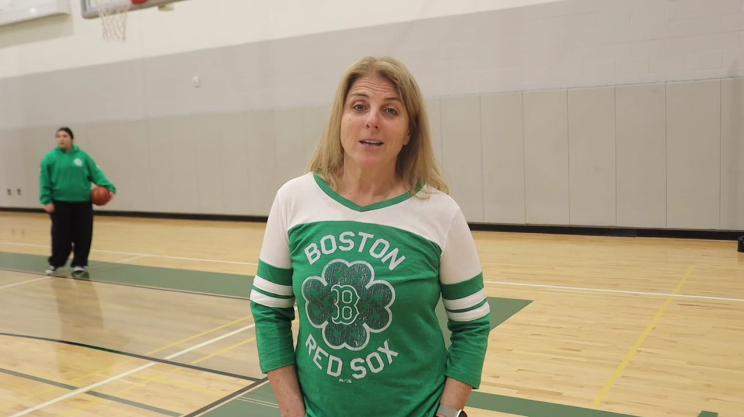Note: This article is a continuation of a previous one. For previous context, please refer to Can You Control Yourself? An In-Depth Review Of ‘The Substance’ Part 1: Elisabeth
Staring down at her note from the nurse, the eerie words “It changed my life,” gleam maliciously in the bright sunlight as Elisabeth Sparkle squints in the hot Los Angeles sunlight.
The sunlight beaming down on Elisabeth resembles the Hollywood spotlight she was showered in for years at the peak of her career, but after aging out of Hollywood, that spotlight begins to burn her.
All of a sudden, Elisabeth is startled when she sees an old classmate from high school, Fred, who is old, balding, and scruffy, but happy to see her nonetheless, even when she forgets who he is.
The contrast from Fred’s appearance compared to Elisabeth shows how men are less scrutinized for their appearance, even when they age, yet women must always exceed the limits of beauty standards and maintain an untouchable beauty.
In fact, the film’s main star, Demi Moore, has not only played Elisabeth Sparkle but has been her.. Moore’s career took off in the late 1980s with her breakout role of Jules in St. Elmo’s Fire, later establishing her as a household name in the 90s and early 2000s.
And just like Elisabeth, Moore has felt the pressure of Hollywood and its harsh criticism throughout her career.
For instance, Moore is 61, yet she has gone to great lengths to make her appearance appear younger.

And just like every other woman in Hollywood, as she has aged, Moore has been rumored to have had plastic surgery done to enhance her physical appearance both on her body and on her face.
In 2010, she addressed the rumors when speaking to Elle Magazine and admitted she had “[work] done, but it’s not on my face.”
Though, now at 61, Moore still appears to not have aged in the past fifteen years, either.
Many doctors have pointed out that Moore has had work done, with speculation of her getting fat from other areas of her body transferred to her face and a mid-face lift surgery as well.
In fact, Moore has gone on record to say she has had a “…love-hate relationship with my body. I find peace when I don’t see my body as my enemy,” she told Us Weekly back in 2012.
And it makes sense she would have that kind of relationship with herself, for any woman, whether in Hollywood or not, feels the weight of having to fit into rigid beauty standards.
But even with having work done, that doesn’t take away from the impact Moore’s portrayal of Elisabeth in The Substance. In fact, it makes her acting feel all the more real.
However, critics have noted how Moore is an inaccurate representation as Elisabeth because of all the work she has had done to make herself look younger.
“I hated The Substance,” Pentucket Regional Senior Middle High School English teacher Cynthia Cromwell stated. “Having Demi Moore, someone who has tons and tons of work done on herself playing a woman who has been shunned from Hollywood because she is ‘too old’ and not ‘attractive enough anymore’ feels like a slap in the face to women the same age who have not had plastic surgery.”
Cromwell makes a point of how Moore and all women in Hollywood who have gotten plastic surgery done either because they were forced to or felt pressured by greedy directors or other corporations with power then project those toxic body standards onto the women and girls who will view that content.
“I have no sympathy for [Moore] or any other woman in Hollywood. They chose that path,” Cromwell adds.
And while Moore’s role in The Substance is a step in the right direction, there is no doubt the film—like all other mainstream Hollywood movies—still falls short of being a symbol of feminism that rejects the idea of plastic surgery and promotes aging and menopause.
And back to the film, while Elisabeth stands in front of Fred, a complete shell of herself but a glamorous one at that, he still thinks of her to be the most beautiful girl in the world and gushes over the success of her career.
Elisabeth, on the other hand, does not reciprocate the same warmth, and when Fred asks her out, she begins to say no, but then asks Fred for his card.
What’s interesting is how Elisabeth asks Fred for his “card” rather than saying “phone number” or “contact information,” likely due to the fact she is so used to the way Hollywood operates so she feels the need to keep him at a distance even though he isn’t remotely famous.
Elisabeth’s reluctance to take Fred’s offer but ends up doing so anyway is a direct comment on how women in Hollywood are taught to never say “no” to men, which is often the reason why Hollywood has an infamous reputation for exploiting women and profiting off of their looks.
In fact, the character of the greasy television studio executive, Harvey represents the former movie producer Harvey Weinstein who sexually abused and harassed hundreds upon hundreds of women in Hollywood. This dates all the way back to the 1970s until the #MeToo movement started in 2017.
The movement was created by women in Hollywood who had been subjected to sexual abuse, exploitation, and harassment from Weinstein who used the women as puppets on strings to do whatever he wanted by threatening to destroy their careers if they were to go against him.
Weinstein is not the only man in Hollywood who has been accused of sexual abuse and exploitation, and he certainly won’t be the last.
Even though Fred didn’t seem to have bad intentions or want to take advantage of Elisabeth, she and so many other women in Hollywood have been conditioned to submit to men even if they have no interest in them.
As Fred hands Elisabeth his number, he drops it in the mud, but still gives it back to her despite how filthy it is. Most people would usually take that as a sign of retreat, or would make another slip, but even though the paper is dirty, the writing is still legible and it did not fall apart.
This small interaction with Fred proves how despite the mistreatment and exploitation she has faced from men in Hollywood, there is still a chance for her to find someone who appreciates her just as Lizzy–the girl people knew before fame.
Yet, she cannot see her own ‘inner sparkle,’ which is shown as she waves awkwardly to Fred with an expression on her face that means she will not be calling him. Thus, Elisabeth continues the cycle of tearing herself apart all women in Hollywood fall victim to.
The scene ends and the audience is introduced to Elisabeth’s apartment.
A portrait on the wall hangs of Elisabeth in her prime. For most women, having a picture like this in their home is a sign of empowerment. But for Elisabeth, it traps her.
Her modern, luxurious apartment, though glamorous, is dull. There is no color, no sign of life, not even in the place she calls home.
Where pictures of family, friends, pets, loved ones, and other things we keep close to our hearts should be instead a portrait of herself to remind her all she has is the face and body she shows the world.
Not that a woman should ever have to sacrifice herself and her career and accept her fate as a wife and a mother, which isn’t always the case for all women. Women have the choice to choose however they want to live their life, but society still pressures them to follow a ‘traditional,’ ‘conservative’ path that doesn’t take the best interests of a woman to heart.
Thus, on the other end, Elisabeth chose to pursue her career, was gravely exploited and abused, leaving her with nothing but the person she used to be. Fargeat’s point in The Substance was not to scared women out of choosing a career, rather by pointing out the corruption of Hollywood, she also confronts sexual harassment in the workplace, especially in corporate culture America.
There she stands, standing in front of her glossy portrait, once the star everyone wanted; now only a shadow of that woman exists.
On a glass table sits a bouquet of roses covered in plastic with a notecard that reads, “Thank you for all these years with us. You were amazing!” Not a gesture done out of love, but to save face.
The note card could have also said, “Thank you for letting us use you until you became human the second you aged and now we no longer want you. You were amazing, but now you’re nothing.” Both would read the same.
Elisabeth stands in front of a large glass window. Her apartment is set up like a storefront display or her tv show set-up, which proves even more just how much she is objectified by society.
She stares out into the abyss, accepting her fate while also grieving the loss of her former self and life. A closeup of the word “were” on the card implies how quickly Hollywood will put women on the chopping block.
The roses sit on the table untouched, as Elisabeth is still in a state of denial. She walks over to her tv and plugs in “The Substance” hard drive the nurse handed her earlier.
The tv goes black, then the screen.
“Lost Cool” by the band Holy F**k ques on. Two identical semicircles that both face the left appear on the screen.
The first semicircle opens at the top, or the back to the circle next to it, attaching the two together. The symbol foreshadows how the process itself works, as the two do not form a full circle together but a different loophole disguised as a whole.
Without the other half circle, there is no whole. Despite the fact the two circles aren’t conjoined to form a perfect circle, they are one.
Transfixed at her screen, Elisabeth watches the program play on her screen.
“Have you ever dreamt of a better version of yourself,” a man’s monotone voice says. “Younger. More beautiful. More perfect.” The screen goes black and the camera faces Elisabeth as she looks for some sort of answer from the screen.
The man’s voice continues as the screen plays out how the substance works, which happens when injected and a new cell division begins, creating the alternate version of the person.
“This is, The Substance,” the man’s voice appears again on the screen, going black with the infamous bold, white, capitalized letters of the words spelled out.
Will Elisabeth choose The Substance? Tune in to the next article to see what happens!


















